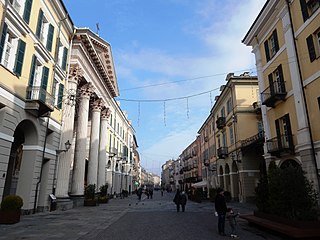
Cuneo is a city and comune in Piedmont, Italy, the capital of the province of Cuneo, the fourth largest of Italy’s provinces by area.

Stura was a department of the French Consulate and of the First French Empire in present-day Italy. It was named after the river Stura di Demonte. It was formed in 1801, when the Subalpine Republic was planned to be annexed to France. Its capital was Cuneo.
Caraglio is a comune (municipality) in the Province of Cuneo in the Italian region Piedmont, located about 80 kilometres (50 mi) southwest of Turin and about 10 kilometres (6 mi) northwest of Cuneo. As of 1 January 2018, it had a population of 6,782 and an area of 41.68 square kilometres (16.09 sq mi).

Valdobbiadene is a town and comune (municipality) in the province of Treviso, Veneto, Italy. Valdobbiadene is a wine growing area: located below the Alpine-Dolomite areas of Veneto, the climate allows the cultivation of the Glera variety of grape.

Camponogara is a town in the Metropolitan City of Venice, Veneto, Italy. It is west of SP13, not far from the nearby Brenta river. Economy is based on the production of wine, including Cabernet and Merlot, and manufacturing of shoes and leather products.

Borgo San Dalmazzo is a comune (municipality) in the Province of Cuneo in the Italian region Piedmont, located about 80 kilometres (50 mi) south of Turin and about 8 kilometres (5 mi) southwest of Cuneo.

Busca is a comune (municipality) in the Province of Cuneo in the Italian region of Piedmont. It is located about 60 kilometres (37 mi) southwest of Turin and about 15 kilometres (9 mi) northwest of Cuneo.
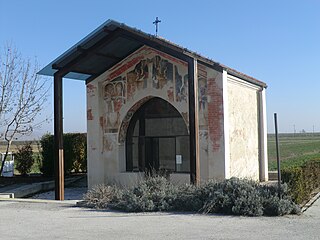
Castelletto Stura is a comune (municipality) in the Province of Cuneo in the Italian region Piedmont, located about 70 kilometres (43 mi) south of Turin and about 10 kilometres (6 mi) northeast of Cuneo.
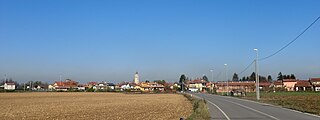
Montanera is a comune (municipality) in the Province of Cuneo in the Italian region Piedmont, located about 70 kilometres (43 mi) south of Turin and about 13 kilometres (8 mi) northeast of Cuneo.
Morozzo is a comune (municipality) in the Province of Cuneo in the Italian region Piedmont, located about 70 kilometres (43 mi) south of Turin and about 14 kilometres (9 mi) northeast of Cuneo.

Peveragno is an Italian town of 5,584 inhabitants (1-1-2017) in the province of Cuneo, in Piedmont.
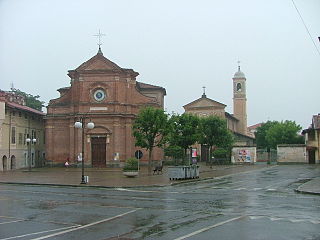
Villafalletto is a comune (municipality) in the Province of Cuneo in the Italian region Piedmont, located about 60 kilometres (37 mi) south of Turin and about 20 kilometres (12 mi) north of Cuneo.

Moncalvo is a village and comune in the Province of Asti in the Italian region Piedmont, located about 45 kilometres (28 mi) east of Turin and about 15 kilometres (9 mi) northeast of Asti on the national road SS 547 which links Asti to Casale Monferrato and Vercelli. Historically it was part of the state of Montferrat and was of particular importance during the early years of the Paleologi period of the marquisate. Its best-known inhabitants were the Baroque painter Guglielmo Caccia and ‘La Bella Rosin’, King Victor Emmanuel II’s favourite mistress and eventually wife.

Bientina is a comune (municipality) in the Province of Pisa in the Italian region Tuscany.
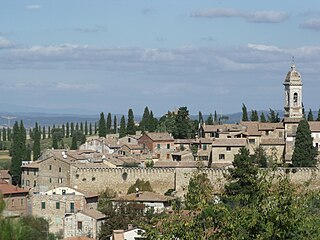
San Quirico d'Orcia is a comune (municipality) of about 2,500 inhabitants in the Province of Siena in the Italian region Tuscany, located about 80 kilometres (50 mi) southeast of Florence and about 35 kilometres (22 mi) southeast of Siena inside the Valdorcia landscape. It is named in honor of Saint Quiricus.
Casalnuovo di Napoli is an Italian comune (municipality) in the Metropolitan City of Naples in the Italian region Campania, located about 13 kilometres northeast of Naples.

Michele Pellegrino was an Italian cardinal of the Roman Catholic Church who served as Archbishop of Turin from 1965 until 1977.

The Diocese of Fossano is a Latin diocese of the Catholic Church in Piedmont, in the Province of Cuneo. It is a suffragan of the Archdiocese of Turin.

Cuneo railway station, or Cuneo Altipiano railway station, is the main station serving the city and comune of Cuneo, in the Piedmont region of northwestern Italy. Opened in 1937, it is the junction of the Fossano–Cuneo, Savigliano–Cuneo, Cuneo–Ventimiglia and Cuneo–Mondovì railways.

Giovanni Battista Arnaud was an Italian painter of frescoes. He mastered as well, the chiaroscuro technique. His work can be found in many churches, palaces and public buildings in different regions of the north of Italy. As well in some churches of France and England. He is also recognized as a great portraitist.




















